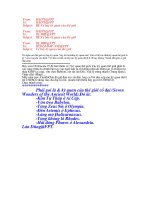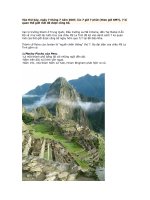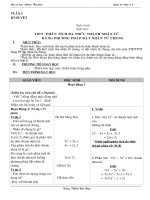- Trang chủ >>
- Mầm non - Tiểu học >>
- Lớp 5
5 7 spreading across the continent
Bạn đang xem bản rút gọn của tài liệu. Xem và tải ngay bản đầy đủ của tài liệu tại đây (6.78 MB, 10 trang )
Fascinating Facts
• Women were so rare during the California gold rush, one
man charged people who came to his wedding five dollars
just to see his bride.
• The chuck wagon used on cattle drives was named for
Charles “Chuck” Goodnight, a Texas rancher who marked
the Goodnight-Loving Trail with cattleman Oliver Loving.
• Each rail for the transcontinental railroad weighed seven
hundred pounds, and it took five men to lift it and fit it
into place.
Genre
Nonfiction
Comprehension Skill
Sequence
Text Features
• Maps
• Sidebar
Scott Foresman Social Studies
ISBN 0-328-14910-1
ì<(sk$m)=bejba < +^-Ä-U-Ä-U
SPREADING ACROSS
THE CONTINENT
by Tammy Zambo
The 1800s brought a period of expansion to the United States
as the country began spreading westward. The West promised
adventure and a chance to make a good living. In this book you
will read about the pioneers who traveled to the West. You will
also read about events that changed their lives and influenced
the growth of the country, such as the gold rush, cattle ranching,
and the transcontinental railroad.
SPREADING ACROSS
THE CONTINENT
Write to It!
Suppose that you have been working as a rider for the
Pony Express. Write a journal entry describing the mail
service, and tell what a typical day might be like.
Write your journal entry on a separate sheet of paper.
Vocabulary
pioneer
gold rush
entrepreneur
telegraph
technology
cattle drive
transcontinental railroad
homesteader
Photographs
by Tammy Zambo
Every effort has been made to secure permission and provide appropriate credit for photographic material. The publisher deeply
regrets any omission and pledges to correct errors called to its attention in subsequent editions.
Unless otherwise acknowledged, all photographs are the property of Scott Foresman, a division of Pearson Education.
Photo locators denoted as follows: Top (T), Center (C), Bottom (B), Left (L), Right (R) Background (Bkgd)
ISBN: 0-328-14910-1
Copyright © Pearson Education, Inc.
All Rights Reserved. Printed in the United States of America. This publication is protected
by Copyright, and permission should be obtained from the publisher prior to any prohibited
reproduction, storage in a retrieval system, or transmission in any form by any means,
electronic, mechanical, photocopying, recording, or likewise. For information regarding
permission(s), write to: Permissions Department, Scott Foresman, 1900 East Lake Avenue,
Glenview, Illinois 60025.
1 2 3 4 5 6 7 8 9 10 V0G1 14 13 12 11 10 09 08 07 06 05
Opener: ©Corbis
2 ©Archives Charmet/Bridgeman Art Library, (Inset) ©Image Farm Inc., (Bkgd) ©Getty Images
Editorial Offices: Glenview, Illinois • Parsippany, New Jersey • New York, New York
3 ©North Wind Picture Archives
4 ©Connie Ricca/Corbis Sales Offices: Needham, Massachusetts • Duluth, Georgia • Glenview, Illinois
5 ©California Historical Society
Coppell, Texas • Sacramento, California • Mesa, Arizona
6 ©Corbis
8 ©Utah State Historical Society, SCL, Utah
11 ©W.I. Hutchinson/Corbis
12 ©Corbis
13 ©Andrew Joseph Russel/Corbis
14 ©J.N. Templeman/Corbis
The Louisiana
Purchase
Pioneers Move West
Before 1804 the United
States was made up of
seventeen states between
the East Coast and the
Mississippi River. That same
year, President Thomas
Jefferson sent Meriwether
Lewis and William Clark to
explore the new United
States territory west of the
Mississippi known as the
Louisiana Purchase.
Americans followed news of
Lewis and Clark’s expedition
with great interest. Soon
Jim Beckwourth was born enslaved,
many of them decided to
and was raised by a Virginia planter
until he gained his freedom. He
discover for themselves what
became a mountain man.
delights lay in that mysterious
western land. The expansion of
the American West had begun.
Even before Lewis and Clark returned, a few adventurous
people set out to make their living as beaver trappers in the West.
These brave souls were almost all men. They became known as
“mountain men.” Some of them, such as Jim Bridger and Jim
Beckwourth, became famous. The mountain men moved from
stream to stream in search of beavers for the fur trade, exploring
and charting trails as they went along. It was these trails that
other Americans soon followed as they too moved west.
2
By 1840 the beaver population had declined and some of the
mountain men returned to the East. Others found different work,
such as guiding pioneers over the Rocky Mountains and the
Sierra Nevada on their way to California or Oregon Territory.
In the 1840s Texas became the twenty-eighth state. The
United States also claimed territory from the British that spanned
Washington, Oregon, and Idaho. Victory in the Mexican War added
lands including California, New Mexico, Arizona, Nevada, and
Utah. Easterners wanted to see these regions. More and more
Americans headed west in search of exciting new lives.
Pioneers such as these ones began traveling to
Oregon Territory in the 1840s.
3
The Pioneers’ Journey
Families moving west left in the spring from Omaha, Nebraska,
or Independence, Missouri. Each family had a covered wagon,
a team of oxen, and several months’ worth of supplies. The
wagons moved single file in one long caravan along trusted trails.
Many followed the Overland Trail, which later split into the
Oregon and California Trails. Others took the Santa Fe Trail
into the Southwest.
Most family members, including children, walked alongside
their wagon during the day so they could drive cattle and other
livestock. They hunted
buffalo, elk, and deer
along parts of the
trail, while their cows
provided fresh milk.
A churn attached to
the wagon made
butter as the wagon
bumped along.
The two-thousandmile journey was long,
difficult, and dangerous.
Wagon trains traveled
at just two miles an
Deep ruts such as these were created by
the wheels of thousands of covered wagons
hour. Pioneers bound
moving along the major pioneer trails. They
for Oregon Territory took
are still visible in some parts of the West.
about five months to
arrive at their destination. Bad weather and rough trail conditions
were constant threats. Illness was another problem, and graves
dotted every trail. Children who began the trip with two parents
might be orphans by the time their caravan reached Oregon.
4
This is the sawmill on the American River where the first gold
nugget was found.
Gold Fever
In January 1848 a work crew was building a sawmill on the
American River in California when a crew member spotted a
nugget of gold about half the size of a pea on the ground. The
West would never be the same.
Word spread quickly that gold had been discovered. People
from all over the region soon headed for the California goldfields.
When many of them found gold, people from back East and all
over the world began to catch “gold fever.” A large number of
people immigrated to California in 1849, which earned them the
name “forty-niners.”
San Francisco and other growing California cities were soon
home to the most diverse population of people in the world, with
European Americans, African Americans (both enslaved and free),
and Native Americans. They came from the East Coast, as well as
from China, Germany, Ireland, Russia, Italy, the West Indies, and
Australia. Less than ten percent of them were women.
5
Some forty-niners stayed in California and earned a paycheck
working for the new mining companies. Others headed home,
searching for gold along the way. Some were lucky. Significant
gold deposits were found in present-day Colorado, and the city
of Denver sprang up as a result. Gold was also found in what
are now Montana, Oregon, New Mexico, Arizona, and Nevada.
Gold Rush Entrepreneurs
California miners often worked in groups, but others worked alone.
Getting the Gold
Getting to California from the eastern states took time and
effort. Most people traveled over land in covered wagons, although
two routes by sea were available. One route went eighteen
thousand nautical miles south around the tip of South America
and north again. The other route went only as far as Panama,
but then passengers had to cross an isthmus, or a narrow strip
of land, by mule and canoe to the Pacific side. There was an
additional risk of catching tropical diseases along the way.
For a few years there was plenty of gold to be found through
placer mining. This method involved searching on or near the
surface of the soil with just a pick, shovel, or pan. By 1852,
however, this surface gold was virtually gone. Investors set up
mining companies in the goldfields. They used heavy machinery
to extract more gold by drilling deep shafts into the ground or by
blasting into hillsides.
6
Most of the people who moved to California during the
gold rush were looking for gold, but some of them set up
businesses to serve the miners. One of these entrepreneurs built
a store right next to the sawmill where the first gold was found.
Others opened laundries or restaurants. Women also found
opportunities by working as entertainers, cooks, or by providing
other domestic services. The operator of a boarding house could
earn up to two hundred dollars per week.
A few entrepreneurs became famous—and wealthy. Levi
Strauss made the world’s first blue jeans, tough pants that were
suitable for mining. Philip Armour grew wealthy with a meat
market and later built a meatpacking empire in Chicago, Illinois.
John Studebaker made wheelbarrows and used his profits to
expand the family’s Indiana business by making wagons and,
later, automobiles. Henry Wells and William Fargo established
reliable banks and securely transported gold during the gold rush.
7
The Pony Express route ran
from St. Joseph, Missouri,
to Sacramento, California.
The Pony Express
The thousands of people who moved to California during the
gold rush longed for news from the East and for letters from
family members. Mail service, however, was irregular and could
take months. The immigrants began to demand faster, more
reliable service.
Three entrepreneurs—William Russell, Alexander Majors, and
William Waddell—operated a successful freight service hauling
supplies to settlers and military posts across the West. The three
men had a daring new idea of setting up a two-thousand-mile
route for transporting the mail in ten days or less. Experienced
horse riders would carry the mail in relay fashion.
The service, the Central Overland California & Pike’s Peak
Express Company, began on April 3, 1860. It soon became known
as the Pony Express. It featured fine, sturdy horses and eighty
riders, men and boys who weighed an average of between 100
and 120 pounds and knew the frontier well. Each rider carried
8
a mailbag draped over his saddle. Because speed
mattered so much, the mail could weigh no more than
10 pounds. A half-ounce letter initially cost five dollars
in gold to mail (about one hundred dollars today). Both
letters and newspapers were printed on thin tissue
paper.
The mail was never allowed to stop on its route,
regardless of weather or time of day or night. Each
rider covered between 75 and 100 miles between relay
stations. Two minutes was allowed every 10 to 15 miles
for changing horses. If somehow a horse was lost or killed along
the way, its rider had to carry the mail on foot to the next relay
station. Sometimes a rider would arrive at a relay station only to
find that no rider was there to relieve him. When this happened,
the rider, and sometimes the same horse, would press on to the
next station—and often the one after that. One rider rode through
a blizzard and subzero temperatures for more than thirty-six hours,
covering 160 miles before a fresh rider could take over.
The Arrival of the Telegraph
The Pony Express operated for only about eighteen months
before the telegraph made it obsolete. This technology, already
used in the East, transmitted messages electrically along wires.
Now it took mere minutes to do what the Pony Express did in ten
days. On October 24, 1861, the extension of telegraph lines to the
West Coast was complete. Two days later, California newspapers
reported that “Our little friend the Pony is to run no more.”
9
Railroad
Cattle trail
Present-day
boundaries are shown
Cowboys drove herds of cattle from their home ranches to
railroad towns along several trails.
The Long Drive
Even before Americans began heading to the far West,
thousands of people settled in Texas and established cattle
ranches. Texas was perfect for raising cattle because the wide
open terrain provided plenty of room for grazing. Ranchers raised
far more cattle than they could sell locally, so they needed
new markets.
Easterners wanted to buy beef, but getting cattle to the
nearest eastern market was very difficult. In the West, though,
cattle could be driven in herds across the plains. The California
gold rush was a prime opportunity for Texas ranchers because
the large numbers of forty-niners demanded more beef than local
ranchers could supply. During the 1850s more than 100,000
cattle were driven from Texas to San Francisco.
10
The peak of cattle driving, though, came after the Civil War as
the eastern railroads began branching farther west. Cattle were
now driven north from Texas to towns such as Sedalia and Dodge
City, Missouri, and Abilene, Kansas. There the cattle were shipped
by rail to Chicago, Illinois, the center of the meatpacking industry.
Cattle drives were usually led by teams of cowboys rather than
by the ranchers themselves. A team was made up of a trail boss
and eight to ten cowboys for a herd of between two and three
thousand cattle. A team also had a cook who drove the “chuck
wagon” and a wrangler who took care of the cowboys’ horses.
Most cowboys were European American, but Mexican and African
American cowboys were also common.
Keeping the cattle calm and headed in the right direction was
the cowboys’ primary duty. The cattle were nervous and could
stampede at the slightest sound or unexpected movement. They
panicked easily while crossing rivers, too, and could begin to
mill, or move in a tight circle until those in the center went under.
Cowboys broke up stampedes
and mills. They tracked down
strays and coaxed stragglers.
They took turns keeping watch
through the night, too, so they
got little sleep. After months
on the trail, a team reached
the town of its destination.
There the cowboys got a bath
and a new set of clothes.
The chuck wagon was designed to
carry cooking utensils and supplies,
such as flour and spices.
11
Driving cattle was a tiring and dirty
business. “There was never enough
sleep,” one cowboy later remembered.
Ranches Move North
Between 1865 and 1890,
about ten million cattle were
driven north from Texas.
Gradually, though, the open
range was fenced off. Ranchers
spread north into the prairies
of Nebraska, North and South Dakota, Wyoming, and Montana.
Cattle drives shortened to a few days, rather than months, but
the winters up north were snowy and cold. On the trail, cowboys
had to find grazing areas where the wind had blown away the
snow, and chop holes in the ice so the cattle could get water to
drink. Sunlight on the snow was blinding and also caused the
cowboys to get sunburned. Frost cracked their lips and skin. The
glory days of the cowboy were over.
The height of the Civil War interrupted construction, but it
resumed once the war was over. Each crew faced immense
challenges. Union Pacific workers were attacked by Native
Americans who controlled the land. Central Pacific workers had to
blast fifteen tunnels through the Sierra Nevada, which was a very
dangerous job.
The crew members were persistent. Union Pacific workers were
mostly immigrants from Ireland, but some were former Confederate
soldiers, Mexicans, Germans, English, and former enslaved people.
Thousands of Central Pacific workers were Chinese immigrants
who had tried looking for gold in California. Each crew raced to see
which could lay track over the most ground.
The Transcontinental Railroad
Before the Civil War, settlers west of the Missouri River began
demanding that the railroad be extended to the West Coast.
Congress authorized a transcontinental railroad in 1862, and
two companies began to build it in 1863, from opposite ends
of the country. The Union Pacific, employing ten thousand men,
worked its way west from Omaha, Nebraska. The Central Pacific,
employing eleven thousand men, worked its way east from
Sacramento, California.
12
Planners did not know where the two lines would join. The competing
crews that prepared the ground for the track even passed each other.
At last, the two lines were connected on May 10, 1869, at Promontory
Point, Utah Territory.
13
A family of homesteaders
stands in front of their
sod house.
Settlers and the Environment
A new period of settlement by pioneers began in 1862 when
Congress passed the Homestead Act. This act provided that
any person who claimed a plot of public land, a homestead, on
the Great Plains and farmed it for five years would be given 160
acres. The transcontinental railroad in 1869 lured settlers farther
west, and farms sprang up all across the Midwest.
Nearly two million people moved to the plains in the 1870s
and tirelessly worked to improve their farms. The homesteaders
built their houses out of sod. They plowed their fields and dug
wells or walked to nearby streams for water. They hoped for
favorable weather to grow strong crops, and they started over
when grasshoppers or hail or drought destroyed those crops. They
tended to each other in sickness, and lent a hand to settlers in
need. Some women became self-taught midwives, helping other
women during pregnancy and childbirth. Their lives were hard, but
they did everything they could to survive and even thrive.
The American pioneer expansion into the West left scars on
the environment. Thirty million or so buffalo once roamed the
plains. In the 1860s, however, the buffalo had to compete with
the pioneers’ livestock for grassland. In addition, more and more
people hunted buffalo simply for sport, and making leather from
their hides became a big business. In one two-year period in
Kansas alone, between one-and-a-half and three million buffalo
were killed.
The land, too, suffered. After California’s surface gold
disappeared, hydraulic mining was used to tear riverbeds apart
to search for more gold. By the 1860s people could see that
hydraulic mining was destroying the rivers, but it took decades
to end the practice. A European, James Bryce, wrote about
destruction such as this: “Why, in your hurry to subdue [control]
and utilize nature, squander [waste] her splendid gifts?”
Luckily, some Americans were just as concerned. In 1872
Congress created the world’s first national park, Yellowstone
National Park, to preserve the beauty of the area. In 1892 John
Muir and other environmentalists formed the Sierra Club to
preserve the Yosemite Valley and the surrounding Sierra Nevada.
Other national parks followed.
14
15
Homesteaders on the Great Plains
Glossary
The 1800s brought a period of expansion to the United States
as
the drive
country
began
spreading
West
cattle
a way
that
cowboys westward.
move largeThe
herds
of promised
cattle
adventure
and
a
chance
to
make
a
good
living.
In
this
bookinyou
north from ranches in Texas to towns along the railroad
willthe
read
about
the pioneers who traveled to the West. You will
late
1800s
also read about events that changed their lives and influenced
entrepreneur a person who starts a new business, hoping to
the growth of the country, such as the gold rush, cattle ranching,
make a profit
and the transcontinental railroad.
gold rush the sudden movement of many people to an area
where gold has been found
Write to It!
Suppose that you have been working as a rider for the
Pony Express. Write a journal entry describing the mail
service, and tell what a typical day might be like.
Write your journal entry on a separate sheet of paper.
Vocabulary
homesteader a settler who
claimed land under the
Homestead Act
pioneer
pioneer an early settler of agold
region
rush
technology the use of newentrepreneur
ideas to make tools that improve
people’s lives
telegraph
telegraph a device that sends messages through wires using
technology
electricity
cattle drive
transcontinental railroad a railroad that crosses a continent
transcontinental railroad
homesteader
Photographs
Every effort has been made to secure permission and provide appropriate credit for photographic material. The publisher deeply
regrets any omission and pledges to correct errors called to its attention in subsequent editions.
Unless otherwise acknowledged, all photographs are the property of Scott Foresman, a division of Pearson Education.
Photo locators denoted as follows: Top (T), Center (C), Bottom (B), Left (L), Right (R) Background (Bkgd)
ISBN: 0-328-14910-1
Copyright © Pearson Education, Inc.
All Rights Reserved. Printed in the United States of America. This publication is protected
by Copyright, and permission should be obtained from the publisher prior to any prohibited
reproduction, storage in a retrieval system, or transmission in any form by any means,
electronic, mechanical, photocopying, recording, or likewise. For information regarding
permission(s), write to: Permissions Department, Scott Foresman, 1900 East Lake Avenue,
16
Glenview, Illinois 60025.
1 2 3 4 5 6 7 8 9 10 V0G1 14 13 12 11 10 09 08 07 06 05
Opener: ©Corbis
2 ©Archives Charmet/Bridgeman Art Library, (Inset) ©Image Farm Inc., (Bkgd) ©Getty Images
3 ©North Wind Picture Archives
4 ©Connie Ricca/Corbis
5 ©California Historical Society
6 ©Corbis
8 ©Utah State Historical Society, SCL, Utah
11 ©W.I. Hutchinson/Corbis
12 ©Corbis
13 ©Andrew Joseph Russel/Corbis
14 ©J.N. Templeman/Corbis









